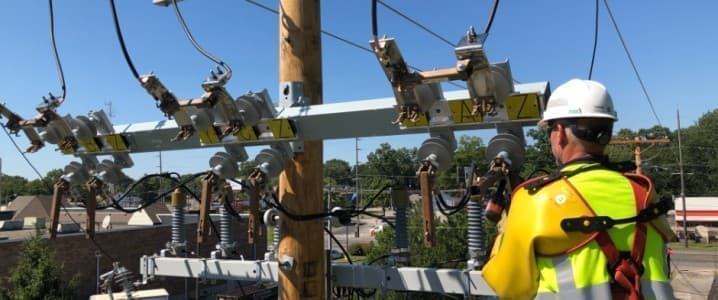Blackouts Are Becoming the NormCan the U.S. Power Grid Be Saved – OilPrice.com

Click Here for 150+ Global Oil Prices Click Here for 150+ Global Oil Prices Click Here for 150+ Global Oil Prices Click Here for 150+ Global Oil Prices Click Here for 150+ Global Oil Prices Click Here for 150+ Global Oil Prices Click Here for 150+ Global Oil Prices Click Here for 150+ Global Oil Prices Natural Gas is Still a Dirty Word, But It’s Here to Stay: WoodMac
Find us on:
The anticipated upcycle in deepwater…Oil prices are set to…China’s famed Shandong teapots, the…Alex KimaniAlex Kimani is a veteran finance writer, investor, engineer and researcher for Safehaven.com. More InfoLast week, a monkey snuck into a substation in Sri Lanka and knocked out power, plunging the island nation into darkness that lasted six hours. The major blackout forced medical facilities and water purification plants in the country to turn to backup generators to maintain critical operations while traffic was gridlocked because traffic lights were not functioning.Unlike many developing nations, Sri Lanka has ample installed power generation capacity and has plenty to spare even during peak demand periods. Unfortunately, Sri Lanka, like many countries, has an outdated power grid that’s vulnerable to widespread disruptions.
And, the U.S. is not much better, with rolling blackouts, freezing homes and skyrocketing electricity prices now the norm rather than the exception. A few decades ago, power outages in vast swathes of the United States were relatively rare and would normally be seen as black swan events. Unfortunately, mass blackouts have now become a regular feature of modern American life. Power outages have increased 64% from the early 2000s while weather-related outages have soared 78%. According to one analysis, the United States now records more power outages than any other developed country, with people living in the upper Midwest losing power for an average of 92 minutes every year compared to just 4 minutes in Japan.Related: Drill Baby Drill Is Dead, Oil Executives SayClimate change and extreme weather events are largely to blame for this sad state of affairs. However, the U.S. is not an exceptional case, with Europe feeling the adverse effects of a rapidly changing climate just as keenly as, if not worse than, the U.S. A closer look at the problem reveals that one fuel could be at the center of the conundrum: natural gas.Over the past two decades, the shale revolution unlocked a deluge of cheap natural gas, and made it easier for the country to transition from coal-fired generation to natural gas plants. Indeed, natural gas is widely touted as the ‘bridge fuel’ as the world gradually moves away from coal as the primary fuel used to generate electricity to renewables thanks to natural gas having a much cleaner emissions profile than coal. Gas now makes up ~41% of U.S. power generation, more than double its share in Europe’s energy mix at 19.6%.The harsh reality is that natural gas plants, even relatively modern ones, are proving to have the worst failure rate when faced with extreme weather compared with other generation methods. During the massive Arctic Blast, gas units accounted for 63% of the failures while representing just 44% of the total installed capacity. The country’s vast network of gas plants and pipelines–the largest in the world–and the regulations that govern them simply were never designed or built without the realities of extreme weather in mind. Gas facilities aren’t uniformly winterized, with many relying on single gas pipelines for supply. Meanwhile, many generators lack the ability to burn an alternate fuel or keep back-up gas on hand in case of emergencies. More alarmingly, even the best gas generating facilities are showing a large degree of vulnerability. PJM Interconnection LLC is the operator of the country’s largest power grid, serving 65 million people in 13 states and Washington, DC, or about a fifth of Americans. The firm’s grid is generally considered to be one of the most reliable in the country thanks to its ample operating reserves and rich shale gas deposits. During the winter blast on Dec. 23, 2022, PJM called a “maximum generation emergency action,” meaning standby plants were supposed to run ramp up to full power. Whereas nearly 20% of those gas plants ran at 100% or more for at least an hour, more than 20% never got above even half capacity while many dropped to 0% output at some point during the emergency. PJM spokesperson Susan Buehler has conceded that generation performance during the storm “was not acceptable,” and added, “What we need, and what we are working on with all of our stakeholders, regulators and policymakers, is for all of our resources to perform when called upon.”Mind you, PJM actually performed better than many neighboring grids, many of which reported widespread electricity interruptions or blackouts, leaving one to wonder how the country’s multiple, highly fragmented and aging grids will manage to stay afloat as Americans continue to consume ever increasing amounts of electricity. During the crisis, a large number of new-model combined-cycle gas plants failed, with some reporting mechanical issues, and failures to start according to people familiar with the operations and official filings. Others couldn’t get the fuel frozen wells, falling pipe pressure or compressor station failures. Others failed to get gas because they are supplied by utility pipelines that prioritize households and businesses first.“That’s a crisis that’s coming. It’s coming a lot closer and a lot nearer and a lot faster than even I thought a year ago when I first said we’re facing a reliability crisis,’’ Mark Christie, a member of the Federal Energy Regulatory Commission, has told Bloomberg.More Renewables And Grid Upgrades
Some experts suggest that extending the existing gas infrastructure can help solve the problem. Many, however, believe that grid upgrades and incorporating more renewable energy is the long-term solution.For decades, the United States has been relying on an aging electrical grid that’s increasingly unstable, underfunded and incapable of taking the country to a new energy future. Despite being the wealthiest country in the world, the U.S. only ranks 13th in the quality of its infrastructure.Indeed, the U.S. power grid is considered the weakest link in the ongoing energy transition.A study by UC Berkeley and GridLab found that it will be economically feasible for renewable energy to power 90% of a reliable grid by 2035, while only depending on natural gas for 10% of annual electricity production. Unfortunately, whereas renewable power sources have grown dramatically in recent years, the country’s aging electrical grid is simply incapable of fully integrating them into our energy use, leading to so much potential power wasted.But, as is usually the case, the biggest challenge remains funding: a Wood Mackenzie analysis has estimated it would cost a staggering $4.5 trillion for the U.S. to fully decarbonize, including constructing and operating new generation facilities; investing in transmission and distribution infrastructure, making capacity payments, delivering customer-facing grid edge technology and more. Suddenly, the $13 billion that the previous administration allocated to upgrading the national grid looks puny.FERC Approves First Major U.S. Electric Transmission UpgradeThankfully, the United States’ aging power infrastructure might soon start getting a much-needed revamp–if the Trump administration is up to it. Last year, the U.S. Federal Energy Regulatory Commission (FERC) approved the first major electric transmission policy update in over a decade, a move expected to speed up new interregional lines to help the grid cope with surging demand. The new rule marks FERC’s first ever update on long-term transmission planning and is seen as a big win for the U.S. administration’s ambitious goal to generate 80% of the country’s electricity from renewables by 2030 and 100% carbon-free electricity by 2035.”This rule cannot come fast enough,” FERC Chairman Willie Phillips, who voted in favor of the final rule, told Reuters. “There is an urgent need to act to ensure the reliability and the affordability of our grid. We are at a transformational moment for the electric grid with phenomenal load growth,” he added, citing the surge in domestic manufacturing, proliferation of data centers, and the surge in extreme weather events.Under the Biden administration, FERC worked to reform how new electric transmissions are approved and paid for. The final rule requires transmission project participants to submit plans for how to split costs between states and companies and also determine whether transmission proposals will meet long-term needs cost-effectively and give operators the ability to re-evaluate projects that face delays or cost-overruns or delays.By Alex Kimani for Oilprice.comMore Top Reads From Oilprice.comBack to homepagePrevious PostUpstream M&A Activity Expected to Decline in 2025Next PostEU to Buy U.S. LNG and Boost Renewables to Replace Russian Gas
Alex Kimani is a veteran finance writer, investor, engineer and researcher for Safehaven.com. U.S. Intelligence Reports Heightened Risk of Israeli Strike on IranChina’s Tariffs Hit U.S. Coal, Oil, and LNG ExportsCanada Revives Old Oil Pipeline Ideas Amid U.S. Trade SpatChina LNG Tariffs Put Future Contracts in JeopardyTanker Market Turns Red Hot as Dark Fleet Gets SqueezedADVERTISEMENT
© OilPrice.comThe materials provided on this Web site are for informational and educational purposes only and are not intended to provide tax, legal, or investment advice.Nothing contained on the Web site shall be considered a recommendation, solicitation, or offer to buy or sell a security to any person in any jurisdiction.Merchant of Record: A Media Solutions trading as Oilprice.com






